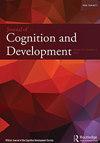言语解释和项目选择作为儿童情景预见性的联合指标
IF 2.1
2区 心理学
Q3 PSYCHOLOGY, DEVELOPMENTAL
引用次数: 0
摘要
情景预见性(episodic foresight, EpF)是未来思维的一个重要方面。这种能力被称为情景预见性(episodic foresight, EpF)。EpF任务通常涉及儿童为未来的情节选择一个项目,然而,与记忆或语义联想相比,未来投射需要成功的程度一直存在争议。利用现有数据(N = 158名3- 5岁儿童),其中包括两种常用的EpF测量方法(“勺子”和绘本任务),我们系统地检查了表面上的未来导向行为(即选择具有未来实用性的项目)在儿童口头解释中的未来导向、情景性和自我投射(通过代词使用来评估)的程度。对于每个任务,我们都考察了项目选择(即所选项目是否可以在未来场景中使用)和年龄对儿童口头解释的影响。结果表明,在绘本任务中,儿童的解释更倾向于未来,使用了更多的人称代词,但在情景性和非人称代词的使用频率上没有差异。此外,在儿童绘本任务解释中,年龄和项目选择是未来取向和情景性的显著预测因子(但结果因试验而异)。在勺子任务中,年龄和项目选择显著预测儿童的未来取向,而项目选择显著预测情景性。我们的研究强调了加拿大儿童的项目选择和解释之间的对应关系,同时也表明口头解释为EpF中涉及的过程提供了独特的见解(例如,未来取向、情景过程和自我投射)。本文章由计算机程序翻译,如有差异,请以英文原文为准。
Verbal Explanations and Item Choices as Joint Indices of Children’s Episodic Foresight
ABSTRACT The ability to project oneself forward in time and imagine a future episode, known as episodic foresight (EpF), is an important aspect of future thinking. EpF tasks often involve children choosing an item for a future episode, yet the degree to which future projection is required to succeed – versus memory or semantic associations – has been debated. Using existing data (N = 158 3-to 5-year-olds) that included two popular measures of EpF (the “Spoon” and Picture-book tasks), we systematically examined the extent to which an ostensibly future-directed action (i.e., selecting the item with future utility) mapped onto future orientation, episodicity, and self-projection (assessed through pronoun use) in children’s verbal explanations. For each task, we examined the effect of item choice (i.e., whether the item selected could be utilized in the future scenario or not) and age on children’s verbal explanations. Results showed that children’s explanations were more future-oriented and included more personal pronouns on the Picture-book task compared to the Spoon task but did not differ in episodicity or frequency of impersonal pronoun use. Further, age and item choice were significant predictors of future orientation and episodicity in children’s Picture-book task explanations (but results varied by trial). On the Spoon task, age and item choice significantly predicted children’s future orientation, while item choice significantly predicted episodicity. Our study highlights the correspondence between Canadian children’s item choices and explanations, while also showing that verbal explanations provide unique insight into the processes involved in EpF (e.g., future orientation, episodic processes, and self-projection).
求助全文
通过发布文献求助,成功后即可免费获取论文全文。
去求助
来源期刊

Journal of Cognition and Development
Multiple-
CiteScore
4.00
自引率
0.00%
发文量
29
期刊介绍:
The Journal of Cognition and Development is the official journal of the Cognitive Development Society (CDS). Some CDS members are concerned with basic research or theory; others focus on policy issues and practical applications. The range of interests includes cognitive development during all stages of life, and we seek to understand ontogenetic processes in both humans and nonhumans. Finally, their interests encompass typical as well as atypical development, and we attempt to characterize both biological and cultural influences on cognitive change and continuity.
 求助内容:
求助内容: 应助结果提醒方式:
应助结果提醒方式:


